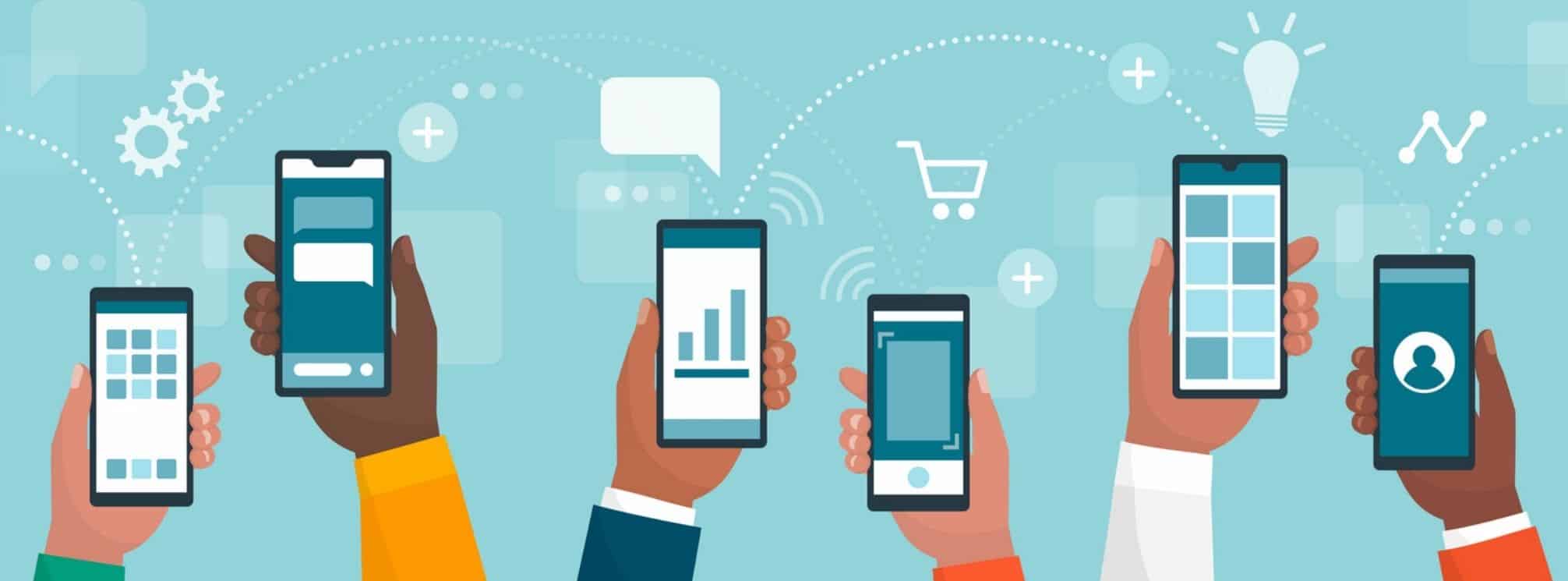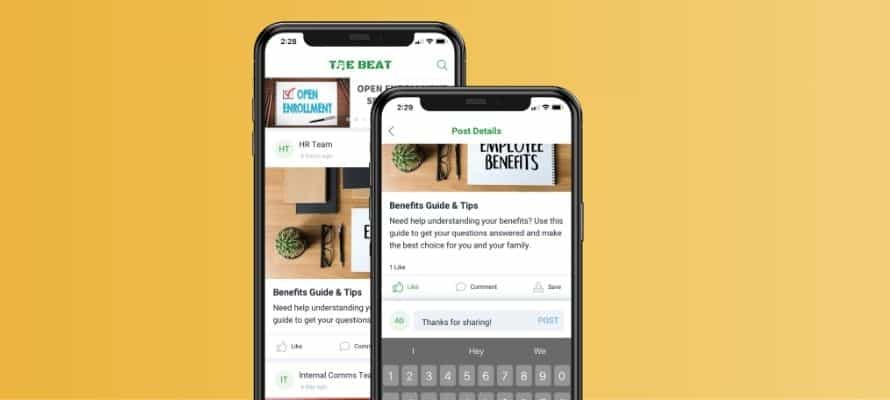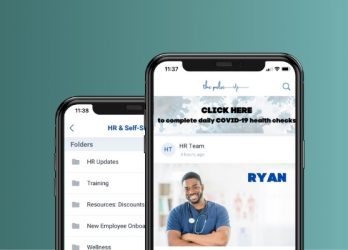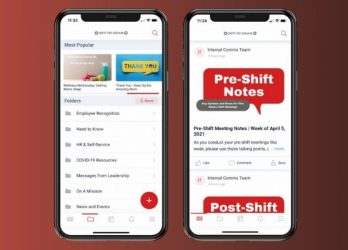Last updated on March 21, 2024 at 06:51 am
One of the most important HR communications best practices for the modern workforce: mobile-first communication. Embracing mobile HR communication is more than just adding to our already overflowing inboxes. It’s about utilizing mobile to break through that clutter and deliver relevant messages at the right time. The future of work is mobile-first. Everything in our personal lives has made the leap to mobile, and so should work to give our employees maximum flexibility and access. Our entire customer experience is made to be mobile-friendly so we can access what we need when we need it. But what about the employee experience? Are your messages getting through? Are you reaching your deskless workforce? Chances are, maybe not as well as you’d think.
What Are Mobile Communications?
Mobile communication is using technology and platforms that are optimized for mobile use for communication purposes.
Within a company, that would include using internal comms channels like a mobile intranet, mobile apps for employees, SMS communication.
Why HR Communication Must Be Accessible
The main push behind embracing mobile communications is accessibility. That’s why a critical HR communications best practice is to embrace mobile-first strategies.
In every other part of life, you have access to information, resources, and other people 24/7. And, for the most part, people who use a computer for work—deskbound employees—have the same luxury. They have access to company email, the intranet, your collaboration tool, face-to-face, town halls, the list goes on.
But there’s a critical part of your workforce that does not: your frontline teams. Even though they make up 80% of the global workforce, they often only have access to printed signage, mailed documents, and face-to-face from their manager. Not a great experience, right? It’s especially not a good experience when it comes to need-to-know, HR communications.
Imagine going to enroll for your benefits, but you can’t access the explainer video that was on the intranet. Imagine a policy update document only living on a manufacturing floor kiosk, shared computer in a healthcare clinic, or on a bulletin board. How engaged would you feel?
But the tech landscape has changed. There are many mobile solutions now that solve this challenge. These new technologies require new strategies to be most effective and help you achieve your goals to:
- Improve compliance,
- Enhance the employee experience, and
- Foster culture and engagement
So, where to begin? Here are our four best practices for creating a mobile HR Communication strategy.

4 HR Communications Best Practices to Reach a Mobile Workforce
1. Think About the Audience First
If you’re sending messages using outdated systems that need to be updated manually (think Excel sheets and paper address books), chances are, you’re missing parts of your audience.
Audience segmentation is critical to your success in communicating with any channel. But mobile allows you to reach more groups than traditional channels. So, when you take your strategy mobile, segmenting and targeting your audiences will be critical. This ensures that content is relevant to the employee who receives it and makes it easier for them to do their jobs safely and effectively.
But beyond that, mobile gives employees access to important messages on a channel that works for them.
Think about a scenario where your third shift is coming to work and they need the latest production schedule. Are they going to scroll through a day’s worth of email to find that information? Think of the impact on the employee experience. What if, instead, you provided that information via mobile? That way, they don’t have to find a kiosk to get the information they need to start working. And what if you took that even further and sent the production schedule out to each shift separately, so they would all receive it when it mattered to them?
Using mobile allows for that critical one-to-one reach where your messages are only seen by the appropriate groups. We help clients use features such as groups and profiles to pinpoint specific teams, workgroups, and locations—aiding in delivering that timely message.
2. Focus on Alignment
Message alignment is important to get right. In your role, you’re constantly being tasked with ensuring there is proper team, goal, and message alignment. With your existing channels, it can be hard to get all your employees on the same page. They might not all receive the same message. What if one team leader is saying one message and another team lead says something else? How will those teams work together? Will we be working towards the same goals?
That’s why, when you introduce mobile as a channel, you’ll want to keep these three priorities in mind.
Message Alignment:
- Are my messages across my channels consistent?
- What audiences am I reaching on each channel? Am I sending the right message to each of those groups?
- Are my managers being sent communication that sets them up to reinforce the same message with their teams?
Goal Alignment:
- Am I frequently sharing the “why” behind my HR comms so employees understand why it’s important?
- Am I sending messages that help managers align their people around common goals?
- Do all employees in the organization understand our key business objectives?
Team Alignment:
- Are my teams (different locations/departments) on the same page?
- If a team isn’t in alignment, is it because they aren’t utilizing the communications and comms tools?
By sending your messages through a mobile app, you gain the ability to present messages to everyone at your company at the same time. This alone can do amazing things for keeping your teams in alignment and all working towards common goals.

3. Remove Roadblocks to Taking Action on HR Communications
We talk about nice-to-know vs. need-to-know messages with our clients, and how to balance each type of message.
In the sea of communications sent, critical communications can get lost. How do you prompt employees to take critical actions on items like certifications, training, or benefits enrollment? More emails? A letter sent to their home address? The timeline and effort involved can put pressure on any hard deadline you have internally.
That’s why we recommend using features like alerts and notifications for mobile hr communication. Content that has a push notification enabled can break through the noise and let an employee know what requires immediate attention. And the stats don’t lie on this one. A recent study by EZTexting shows 90% of all messages sent are read within three minutes and have an open rate 138% greater than that of email.
Taking those critical HR communications directly to your employees’ mobile devices just makes sense.
4. Make Your Content Engaging
Engagement with your employees has to happen beyond your facility. Traditional methods of increasing employee engagement aren’t effective, which we’ve seen from years of stagnant (or decreasing) engagement rates.
Engagement isn’t about fun on-site activities. It’s about creating a sense of belonging, having a valued voice, physical and psychological safety, and understanding how your role contributes to the company’s success.
And right now, employees are burnt out and the employment landscape is competitive. Your people are looking to your company as a beacon for leadership and trust. Genuinely engaging your people has become a top priority.
One of the best ways to ensure your engagement program meets employee needs is an employee survey. Using a survey through your mobile app allows for the end-user to provide real-time feedback on their experience. Think about quick pulse surveys and being able to provide rapid results back to leadership on how your workforce is managing. And then take their feedback. Ask them what they need and give it to them. This will boost their engagement with your content and lead to better results.
Resources to Help You Take the Next Step
To help you with these steps towards improving mobile HR communication, we have created the following tools. Use these to assess the effectiveness of your communications now and build towards successful employee communications strategies.
- Communication Audit Guide: It is important to conduct an HR communications audit and this process is instrumental in determining how internal comms is functioning at your organization and where any gaps might exist. As you begin forming your mobile hr communication strategy and annual budgets, the data and information you gather from your audit will also help you hone in on the right strategy and changes that need to be made.
- Stop, Start, Continue Analysis: You need to be constantly evaluating our current tactics and communication strategies. With the workforce and technology changing rapidly, auditing and examining what we do and how regularly is critical. In this guide, you’ll learn how to conduct a Stop, Start, Continue Analysis of your HR communications strategy.
- Guide for creating communications campaigns: Effective communications come down to creating successful campaigns. In this guide, you will find steps for setting objectives before creating a campaign. Tips for determining the right cadence and content for your campaigns and campaign best practices from change management to embracing 360-degree messaging.
Subscribe To The theEMPLOYEEapp Newsletter
Comments are closed.





